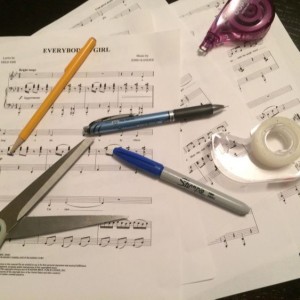
Photo credit: Laura Ware.
Finding and Cutting Songs
Explore this module
Introduction
In this module, we will discuss how (and where) to look for well-written, under-performed songs, and how to properly cut them to show your best in a college audition.
Terminology
- Audition Cut: A 1-2 minute monologue from a play, or short (16-bar) and long (32-bar) portions of a song.
- Bell Tone: The starting note you ask the pianist to give you before you sing.
- Belt: References a singer who sings in a more chest voice dominant manner.
- Belt/Mix: This is a contemporary term that references a singer who is able to balance the chest and head voice depending on what the repertoire requires.
- Coda: A musical section that musically and lyrically wraps up a song.
- Legato: Playing or singing in a smooth flowing manner, without breaks between notes.
- Legit: References a singer who has what has been considered a more classical approach to singing.
- Passaggio: Italian for passageway, the place where you transition from chest voice to head voice.
- Range: How high and low you can comfortably sing.
- Refrain: Another term for the chorus of a song.
- Tessitura: The area of your voice where the majority of a song sits.
- Verse: An introduction to a song.
- Voice Type: The classification of your voice based on your vocal range.
Related Expenses
Sheet music, voice lessons, audition coach, and accompaniment tracks.
Context & Analysis
Preparation
Now that you have a grasp of some of the general rules about picking our audition repertoire, let’s get specific about how to find songs that are not only appropriate for you, but cut well for auditions.
Basic Criteria In addition to understanding your essence and finding something you love to sing, there are several other basic criteria each of
to read our learning module for Finding and Cutting Songs and to unlock other amazing theatre resources!Links & Media
Quizzes

Laura Josepher
New York-based theatre director and acting coach
